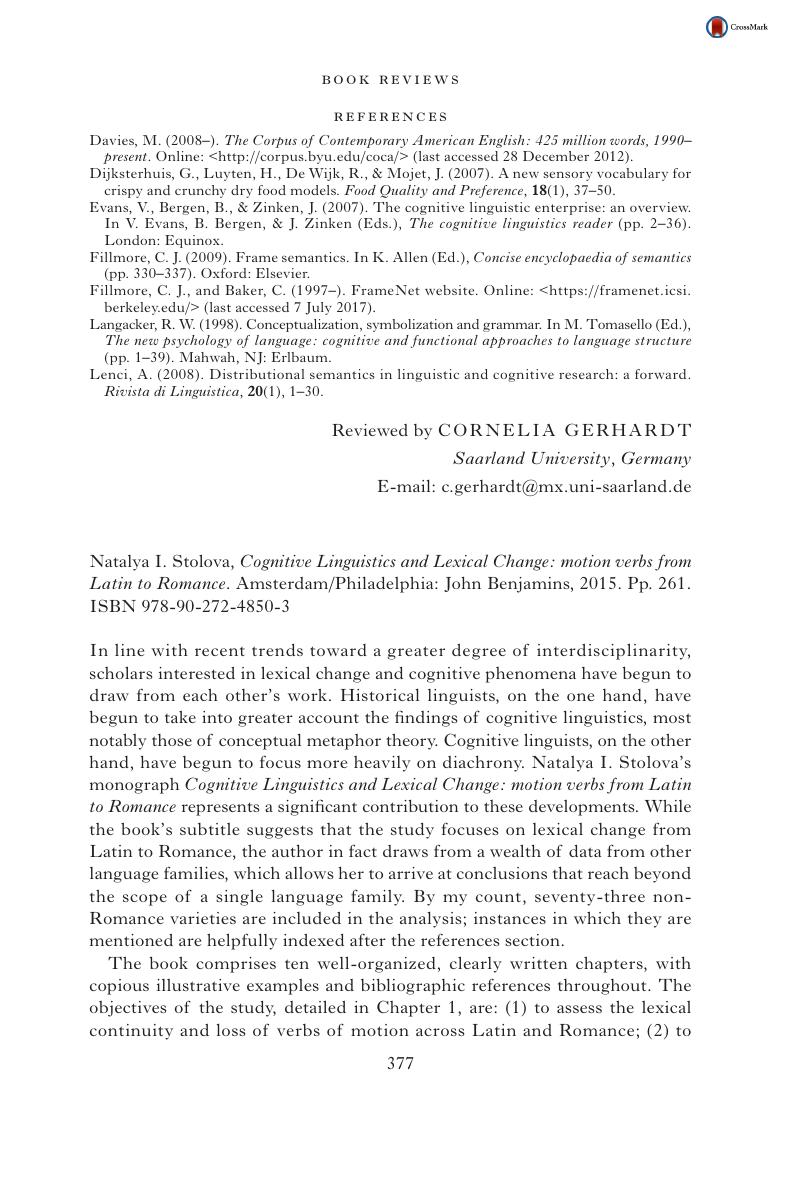No CrossRef data available.
Article contents
Natalya I. Stolova, Cognitive Linguistics and Lexical Change: motion verbs from Latin to Romance. Amsterdam/Philadelphia: John Benjamins, 2015. Pp. 261. ISBN 978-90-272-4850-3
Review products
Natalya I. Stolova, Cognitive Linguistics and Lexical Change: motion verbs from Latin to Romance. Amsterdam/Philadelphia: John Benjamins, 2015. Pp. 261. ISBN 978-90-272-4850-3
Published online by Cambridge University Press: 04 December 2017
Abstract
An abstract is not available for this content so a preview has been provided. Please use the Get access link above for information on how to access this content.

- Type
- Book Review
- Information
- Copyright
- Copyright © UK Cognitive Linguistics Association 2017
References
references
Baldi, P. (2006). Towards a history of the manner of motion parameter in Greek and Indo-European. In Cuzzolin, P. & Napoli, M. (Eds.), Fonologia e tipologia lessicale nella storia della lingua greca: Atti del VI Incontro Internazionale di Lingüística Graca, Bergamo, settembre 2005 (pp. 13–31). Milano: FrancoAngeli.Google Scholar
Croft, W., Barðdal, J., Hollmann, W., Sotirova, V., & Taoka, C. (2010). Revising Talmy’s typological classification of complex event constructions. In Boas, H. C. (Ed.), Contrastive studies in Construction Grammar (pp. 201–236). Amsterdam & Philadelphia: John Benjamins.Google Scholar
Lakoff, G., & Johnson, M. (1980). Metaphors we live by. Chicago: University of Chicago Press.Google Scholar
Lakoff, G., & Johnson, M. (1999). Philosophy in the flesh: the embodied mind and its challenge to Western thought. New York: Basic Books.Google Scholar
Lakoff, G., & Johnson, M. (2003). Metaphors we live by, 2nd ed. Chicago: University of Chicago Press.Google Scholar
Stolova, N. I. (2003). Verbs of motion in the Romance languages. Unpublished PhD dissertation, University of Pennsylvania.Google Scholar
Stolova, N. I. (2008). From satellite-framed Latin to verb-framed Romance: Late Latin as an intermediate stage. In Wright, R. (Ed.), Latin vulgaire – latin tardif VIII: Actes du VIIIe Colloque International sur le Latin Vulgaire et Tardif, Oxford, 6–9 septembre 2006 (pp. 253–262). Hildesheim: Georg Olms; Zürich: Weidmann.Google Scholar
Stolova, N. I. (2010). La evolución del campo conceptual de movimiento: Una perspectiva cognitiva onomasiológica. In Iliescu, M., Siller-Rung-galdier, H., & Danler, P. (Eds.), Actes du XXVe Congrès International de Linguistique et de Philologie Romanes, Innsbruck, 3–8 septembre 2007, vol. III (pp. 187–195). Berlin & New York: De Gruyter.Google Scholar
Talmy, L. (1983). How language structures space. In Pick, H. L. & Acredolo, L. P. (Eds.), Spatial orientation: theory, research, and application (pp. 225–282). New York & London: Plenum.CrossRefGoogle Scholar
Talmy, L. (1985). Lexicalization patterns: semantic structure in lexical forms. In Shopen, T. (Ed.), Language typology and syntactic description, vol. iii: grammatical categories and the lexicon (pp. 57–149). Cambridge: Cambridge University Press.Google Scholar
Talmy, L. (2000). Toward a cognitive semantics. vol. i: concept structuring systems; vol. ii: typology and process in concept structuring. Cambridge, MA & London: MIT Press.Google Scholar
Talmy, L. (2007). Lexical typologies. In Shopen, T. (Ed.), Language typology and syntactic description, vol. iii: grammatical categories and the lexicon, 2nd ed. (pp. 66–168). Cambridge: Cambridge University Press.Google Scholar
Talmy, L. (2009). Main verb properties and equipollent framing. In Guo, J., Liven, E., Budwig, N., Ervin-Tripp, S., Nakamura, K., & Özçalýşkan, S. (Eds.), Crosslinguistic approaches to the psychology of language: research in the tradition of Dan Isaac Slobin (pp. 389–402). New York & London: Psychology Press.Google Scholar
Talmy, L. (2012). Main verb properties. International Journal of Cognitive Linguistics, 3(1), 1–23.Google Scholar



